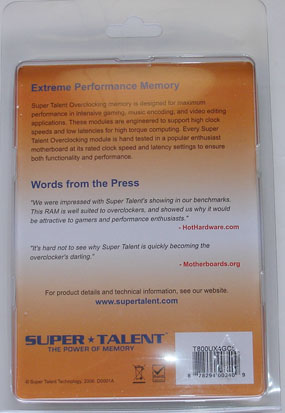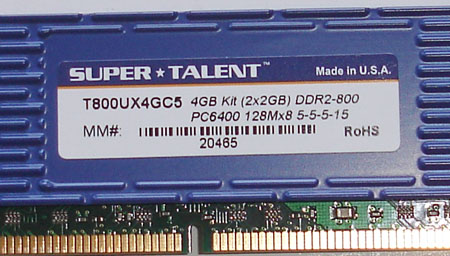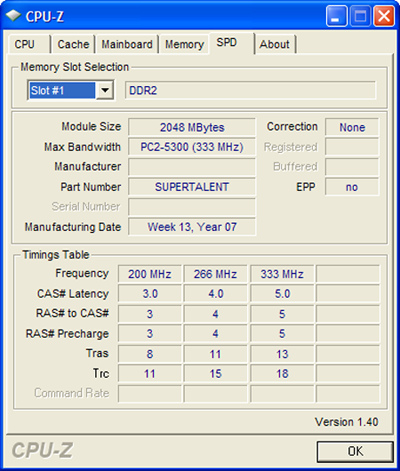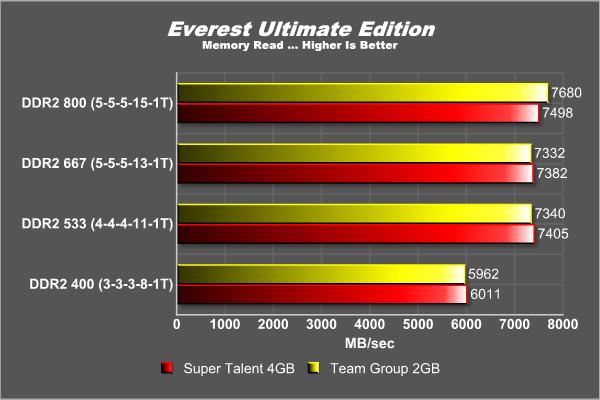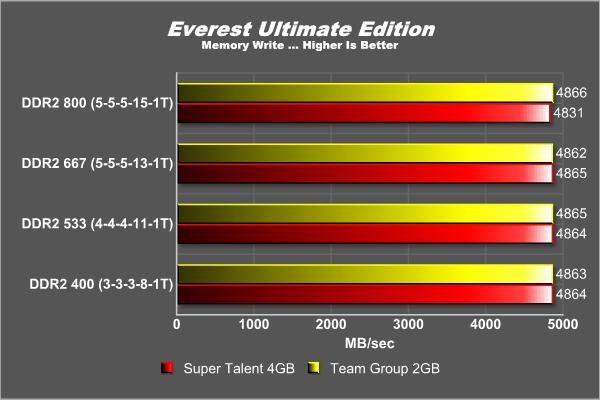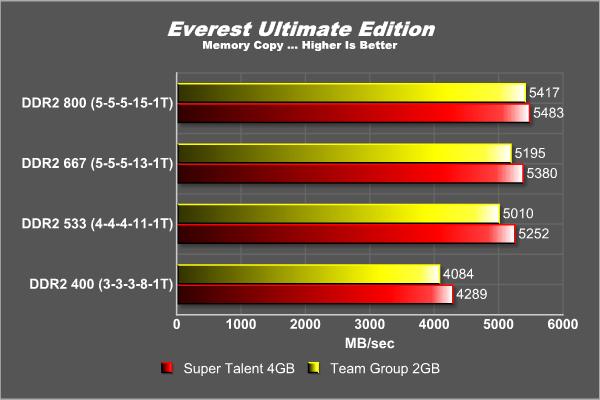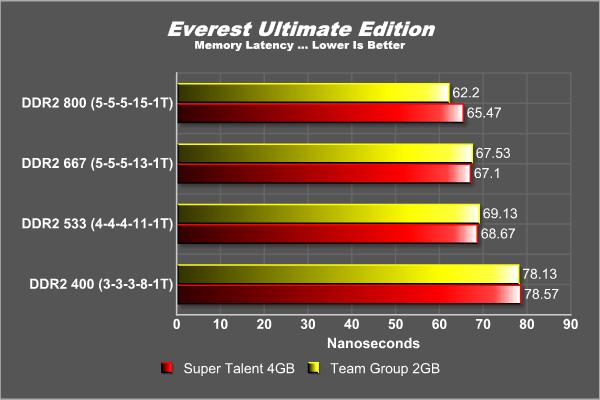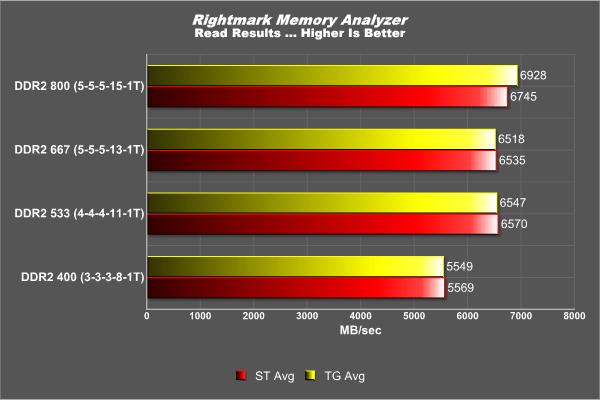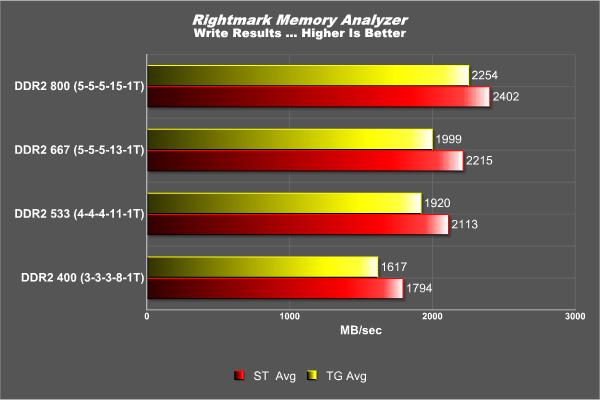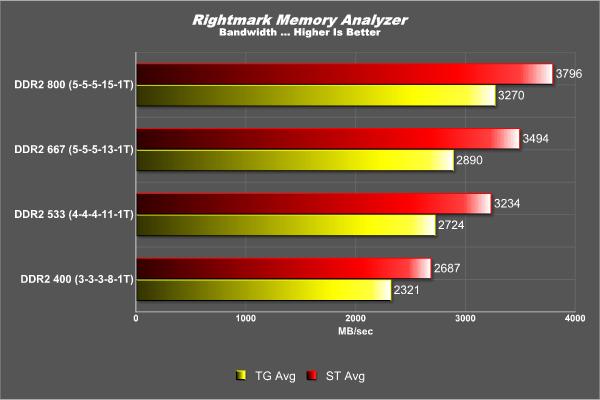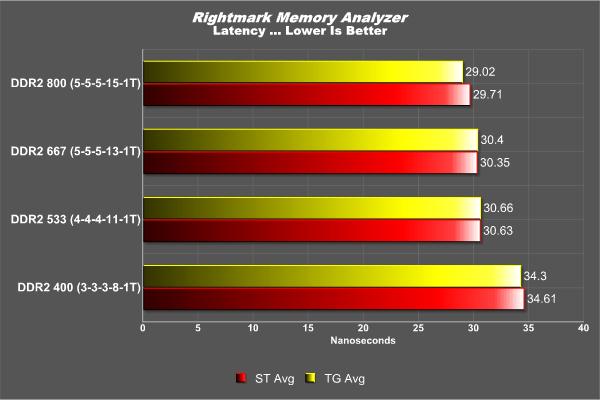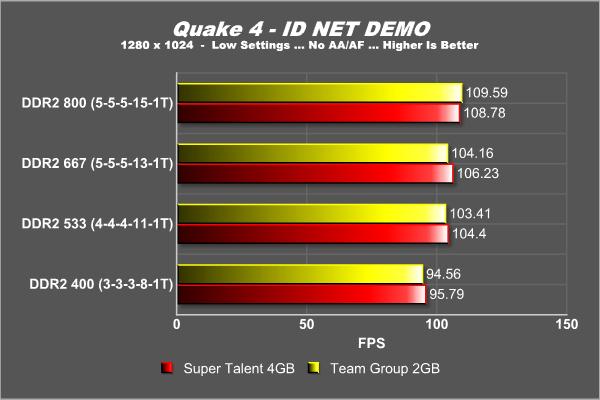With the price of DDR2 taking a huge plunge, it is a great time for any user to upgrade their memory to larger capacity. The release of Vista means that 2 GB is no longer for enthusiasts but rather a somewhat necessity as a clean Vista installation will consumes at least 600MB of RAM. Sooner or later the 4 GB will be the norm and should definitely be the amount of memory for any enthusiasts. The Super Talent, a company that is known for great memory, has released the T800UX4GC5, the 2x2GB DDR2-800. Read our review and see how well this memory performs and if it would fit your budget while getting you the performance you strive for.
INTRODUCTION
SUPER TALENT
Headquartered in San Jose, California, Super Talent Technology designs and manufactures DDR and DDR2 memory modules and Flash based storage devices for computers and consumer electronics.Super Talent’s Silicon Valley based electrical, mechanical, and software Engineering teams develop leading-edge DRAM and Flash memory solutions for a multitude of applications. Our US-based engineering enables Super Talent to bring advanced new products and technologies to market well ahead of the competition. A leading innovator, Super Talent holds over 100 patents on DRAM and Flash module design and manufacturing processes, making Super Talent one of the world’s chief patent holders in memory device categories. Super Talent is an active member of JEDEC, the association that defines future memory standards. The company is a technical leader in producing industry standard memory modules as well as in developing custom memory solutions.
FEATURES AND SPECIFICATION
- 2x 240-pin DDR2 DIMMs
- Non-ECC, Unbuffered
- 4GB kit (2x 256Mx64)
- DDR2-800, 5-5-5-15 latencies
- Dual rank
- Chip Architecture: 2x 16 chips, 128Mx8
- Cast aluminum high-efficiency (HE) heatspreader
- SPD*: DDR2-800, 5-5-5-15 latencies (CAS, tRCD, tRP, tRAS)
- Test Voltage: 2.1V
- Made in USA
- Super Talent Lifetime Warranty
The Super Talent T800UX4GC5
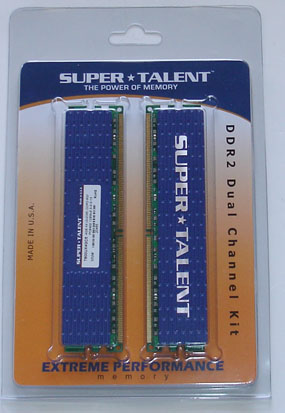
Like many memory manufactures on the market, Super Talent has chosen to package their ram in plain plastic packaging, where users are able to see the memory on the front of the package. The memory sticks are well protected inside the package because there are small protrusions inside the package which holds the memory sticks firmly inside the package.
The package has an insert which doesn’t provide much information except a few quotes from review sites about Super Talent’s memory and the link to the Super Talent’s website.
The memory comes with heatsink already attached to the unit. The name Super Talent is written across the front of the heatsink. The back of the memory has a sticker which provides the RAM’s timing. Unlike some memory heat spreaders which cover the whole ram, the Super Talent’s heat spreader sandwiches the memory.
The timing and clock speed of the memory is clearly printed on a sticker outside of the heat spreader. The memory is rated to run at speed of DDR2-800 and at timing of 5-5-5-5-12 at 2.1v.
INSTALLATION
The Super Talent T800UX4GC5 is recognized without any problem in my EVGA 680i motherboard. However, the memory is not automatically detected at 800MHz (5-5-5-15) as Super Talent’s specification, rather it is detected at 667MHz with 5-5-5-15 timing. I am slightly surprised to see this since the package states that it should be able to run at DDR2-800 speed. I manually enter the correct speed and timing and the system boots without any issue so the RAM is definitely bootable at specified speed and timing.
My suspicion is that Super Talent probably tests their DDR2-667 to see if it runs stable at DDR2-800. Those memory sticks that passed the test will then get labeled and sold for DDR2-800. The CPU-Z reveals that the RAM is PC2-5300.
TEST SETUP
Initially, I had planned to test the memory on a Windows Vista 64-bit operating system. However, due to the fact that I do not have any other 4 GB Ram which I could use to compare, I decided to test the ram under Windows XP for now. I may update the result later with the score of Vista benchmark and see the effect of the amount of memory for Windows Vista.
|
System Configuration |
|
|
Processor |
Intel E6600 Core 2 Duo (stock speed) |
|
Motherboard |
EVGA nForce 680i SLI (BIOS P27) |
|
Memory |
Team Group TXDD2048M800HC4DC-D (2x1GB) |
|
Hard Drive |
Seagate Barracuda Barracuda 7200.10 SATA ST3400620AS (16MB cache) Western Digital WD2500KS-00MJB0 SATA (16MB cache) |
|
Graphics Cards |
EVGA 8800 GTX KO ACS3, ForceWare driver 158.19 |
|
Sound Card |
Creative X-FI (Driver 2.9.7) |
|
Power Supply |
NZXT 1000KW |
|
Operating System |
Windows XP SP2 |
| Chipset Driver |
ForceWare 9.53 |
|
Memory Test Protocol |
||||||
|
DDR2 |
400 |
533 |
667 |
800 |
||
|
Memory |
3-3-3-8-1T |
4-4-4-11-1T |
5-5-5-13-1T |
5-5-5-15-1t |
||
|
VDimm |
1.8 |
1.8 |
1.8 |
2.1 |
||
|
CPU |
2.4 |
2.4 |
2.4 |
2.4 |
||
|
CPU |
4:3 |
1:1 |
4:5 |
2:3 |
||
|
Mushkin XP2-8500 2GB |
||||||
|
DDR2 |
400 |
533 |
667 |
800 |
||
|
Memory |
3-2-2-6 |
3-3-3-9 |
3-3-3-8 |
3-3-4-9 |
||
|
VDimm |
1.8 |
1.9 |
2.2 |
2.25 |
||
|
CPU |
2.4 |
2.4 |
2.4 |
2.4 |
||
|
CPU |
4:3 |
1:1 |
4:5 |
2:3 |
||
| Software | |
|
Everest Ultimate 4.00.976
|
|
|
RightMark 3.72
|
|
|
Sandra XI SP 1a
|
|
|
Super PI/MOD 1.5 XS |
|
|
FEAR v 1.08 (1280×1024, lowest settings, no AA/AF) |
|
|
Quake 4 v1.2 (1280×1024, lowest settings, no AA/AF) |
TEST RESULTS
Everest Ultimate
The Super Talent T800UX4GC5 generally has a slightly better read throughput when compared to the Team Group TXDD2048M800HC4DC-D, however, the performance seems to top off at DDR2-667. When both memory modules are running at DDR-800, we see the Team Group’s memory actually has better throughput.
Once again, the write performance of both memory modules are almost identical to each other, however, just like the read performance, we see the Team Group 2GB out-performs the Super Talent’s memory module at DDR2-800.
The copy performance of the Super Talent is much better than the Team Group. Even at DDR2-800, the Super Talent 4GB is still able to outperform the Team Group’s 2GB. However, the performance lead of the Super Talent 4GB is reduced as the clockspeed is increased.
Despite the fact that both memory modules are running at the exact timing, we see that the Super Talent 4GB has a slight lead over the Team Group 2GB at speed lower than DDR2-800 (although the differences are so small that they are virtually the same) but theTeam Group 2GB has a noticeably lower latency than the Super Talent’s 4GB at DDR2-800. I am not sure this is attributed to the amount of the RAM (2GB vs 4GB) or the type of memory chip that was used in each module.
RightMark
We see a similar result in the RightMark as we have seen with Everest that the read performance of the Team Group outperforms the Super Talent at DDR2-800, about 2% increase for the Team Group 2GB.
The write result of the RightMark is somewhat interesting. We see a better throughput for Super Talent across the different speed. This is different from what we have seen with the Everest. The Super Talent 4GB has a 5~10% lead over the Team Group 2GB depends on the speed.
The Super Talent’s bandwidth performance is also much better than the Team Group’s module. The Team Group 4GB has about 16% lead lead over the Super Talent 2GB and the lead is independent of the memory speed.
Once again, the RightMark has confirmed with the Everest test which the latency of the Super Talent is slightly faster at speeds lower than DDR2-800 but Team Group 2GB performs noticeably faster over the Super Talent at DDR2-800.
TEST RESULT, cont.
Sandra XI
With the Sandra buffered and unbuffered benchmarks, we can see why we get different results in the write performance between Everest and RightMark benchmark. The Everest benchmark actually measures the buffered bandwidth and the RightMark benchmark measures the unbuffered bandwidth. The Super Talent 4GB’s unbuffered bandwidth is surpassing the Super Talent 2GB by about 16%.
SUPER PI /mod 1.5 XS
SuperPi is a good way to measure the system’s CPU and memory performance as the result is highly dependent on both components. We see that the Super Talent 4GB outperforms the Team Group’s 2GB. However, I am not sure this difference in the performance is due to the amount of RAM (as SuperPi could be memory amount dependable). However, we can see the Super Talent’s lead over the Team Group is getting smaller as the memory speed is increased, which does confirm with what we have seen so far with the Super Talent’s RAM.
TEST RESULTS, cont
F.E.A.R.
QUAKE
Many of current games on the market really can’t take the advantage of 4GB yet as they are not too memory hungry. However, things should change in the near future, specially since Windows Vista takes at least 600MB of memory resources and the future games will definitely take the advantage of 64-bit operating system and more RAM. Looking at the performances in F.E.A.R and Quake, we can see the similar trends we have seen so far with the Team Group. Both in F.E.A.R. and Quake, the Super Talent 4GB is able to gain a few frame rates over the Team Groups 2GB. However, once again, when the speed is at DDR2-800, the lower latency and better throughput of the Team Group has put it over the Super Talent, specially in F.E.A.R (as the Team Group memory module is able to get an average 241 FPS while the Super Talent module gets 228 FPS).
OVERCLOCKING
Originally, I had high hope for the overclocking result as most DDR2 has no trouble overclocking at least near 1000MHz. However, the overclocking result of the Super Talent T800UX4GC5 was quite disappointing. I was able to push the memory to 865MHz but the system was not stable even with 2.4 V. The system was able to boot to the BIOS but was not stable under Windows for any benchmarks. I ended up having to drop the speed to 860MHz with the timing of 5-5-5-15.
If my suspicion about the fact that this memory is actually an overclcoked version of the DDR2-677, then it won’t be too surprising to see the limited overclocking beyond 800MHz as it has been stretched quite far from the 667MHz.
CONCLUSION
The Super Talent T800UX4GC5 seems to be targeted toward budget customers who need 4GB of RAM. It seems to me that this RAM is an overclocked DDR2-667 that has been tested to run stable at DDR2-800 with 2.1V (although it is bootable at 1.8V without any problem) at fairly loose timing of 5-5-5-15. Sure, it is not the fastest memory on the market but as the old saying goes, “you got what you paid for”, and the the T800UX4GC5 certainly fits into this category. You get a loose timing 4GB of memory that will satisfy the need for multi-tasking and memory demanding games but do not expect earth shattering performance.
I have no issue running this memory in my system except it was not automatically being detected at the correct speed and timing. The memory is stable but the overclocking potential of the RAM is rather limited and disappointing, but once again, since it’s not really meant for extreme enthusiasts and overclockers, one shouldn’t expect too much out of this RAM.
At the end, it’s all about the price and performance ratio. Having 4GB of memory should definitely be helpful in the ever increasing memory demands in games and applications. The Super Talent T800UX4GC5 delivers what it has promised, the stability to run 4GB in dual channel mode at DDR2-800 and that’s pretty much it. We may overlook the limited overclocking ability of the RAM since the memory is priced at a comparable price ($309.99 at Newegg at the time of the review) among other manufacture’s memory with similar specification. The T800UX4GC5 would be a good choice for any budget buyer who is looking to upgrade their system with 4GB of memory.
The Super Talent T800UX4GC5 will receive a score of 7.5 (good) out of 10. This memory would be a great choice for budget users who need 4 GB of memory.
Pros:
+ 4GB dual channel at DDR2-800
+ Heatspreader
+ Competitive price
+ Lifetime warranty
Cons:
– Speed is not automatically detected.
– Limited overclocking
– Performance seems to top off at DDR2-800
 Bjorn3D.com Bjorn3d.com – Satisfying Your Daily Tech Cravings Since 1996
Bjorn3D.com Bjorn3d.com – Satisfying Your Daily Tech Cravings Since 1996

